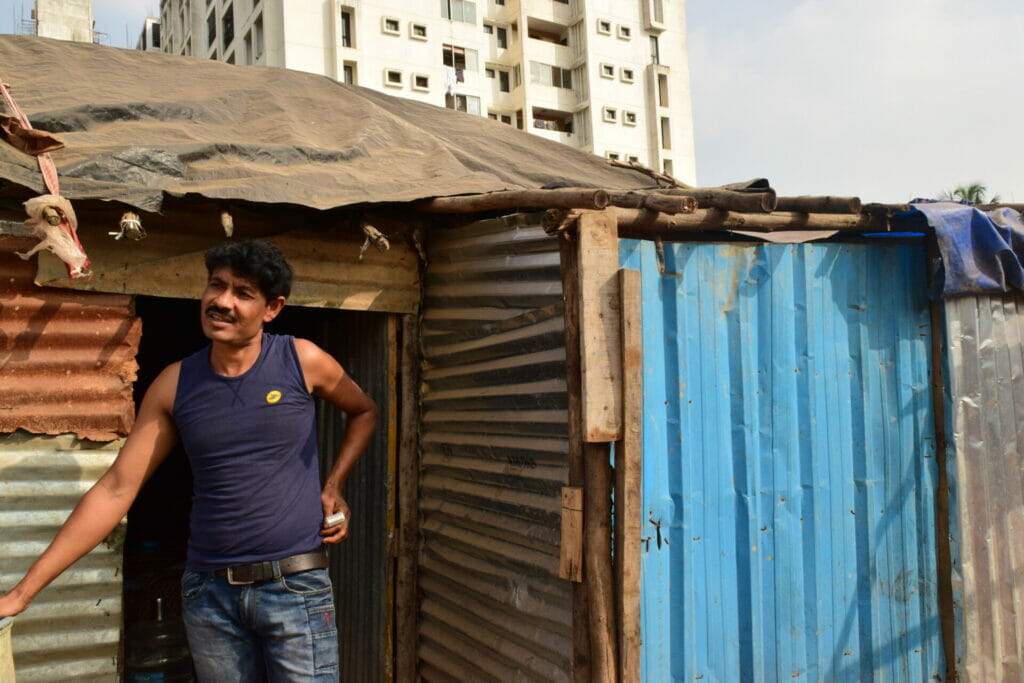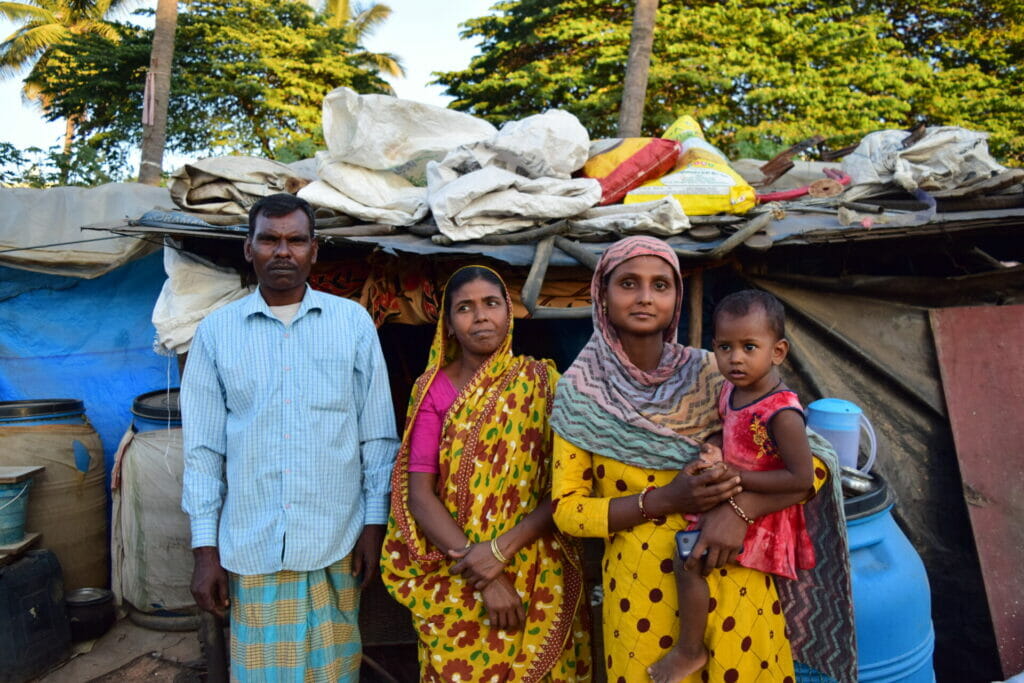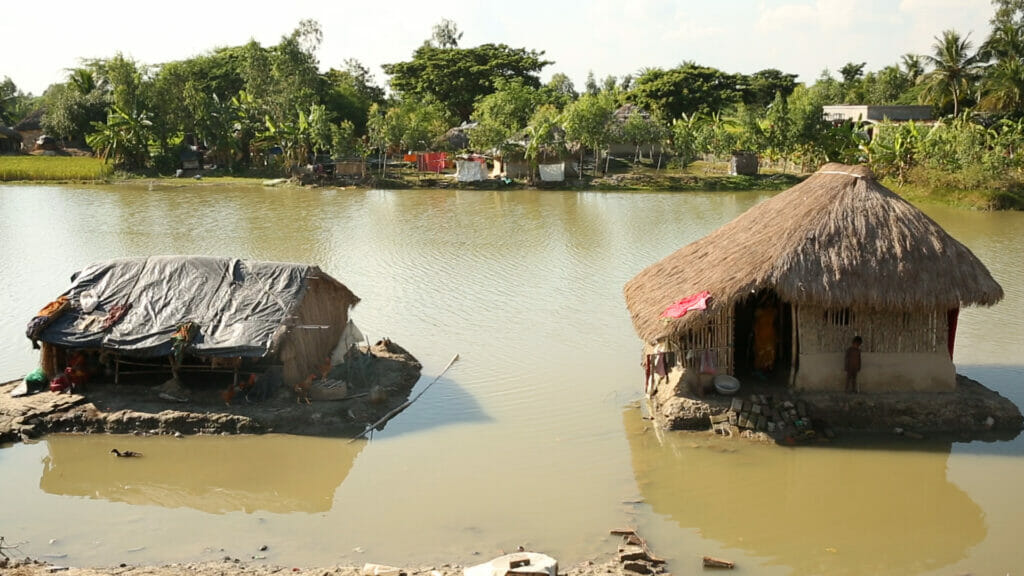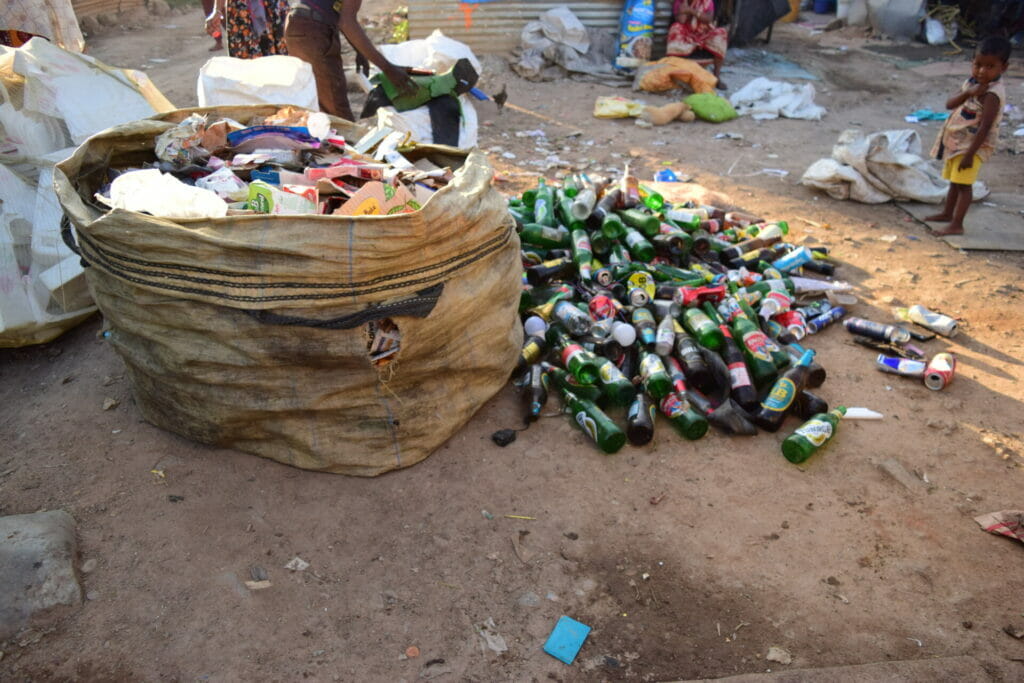Adar Ali Sheikh, 38, came to Bengaluru two years after the devastating 2002 cyclonic storm hit his hometown in Nadia district, West Bengal. It wrecked his home and the fields he worked in as an agricultural labourer, entrapping him in debt. He travelled almost 2,000 kilometres to find a job as a car washer in Bengaluru so he could pay off his lenders.
“I had to leave because we couldn’t save the harvest, and the landowner (who he had leased the land from) demanded we pay the agreed amount. What would I have done?” he asks.
Adar lives in a settlement nicknamed Lal Mitti by the residents in Thubarahalli in east Bengaluru. The colony, with 40,000 residents, and his immediate neighbours have similar stories to share about how climate extremities forced them to migrate to Bengaluru.

A report by the Centre for Science and Environment (CSE) assessing extreme weather events in India mentions that India faced extreme weather events during 88% of the days from January to September 2022. In the report, extreme weather events is defined as “occurrences that are rare at a particular place and time of year.”
The report also quotes the Indian Meteorological Department’s classification of events like lightning and thunderstorms, heavy to extremely heavy rainfall, landslides and floods, cold waves and heat waves, cyclones, snowfall, dust and sandstorms, squalls, hailstorms, and gales as “climate extremities”.
While farmers are entitled to compensation for crop damage, this is restricted to land-holding farmers which leaves the majority of the workers in the sector, consisting of landless or tenant farmers working on leased land, to fend for themselves.
Climate change and crop failure
Like Adar, Radha* migrated to Bengaluru from Nadia two years ago. She works as a domestic worker in an apartment complex in the city, but lives in another settlement in Chiranjeevi Layout close to the Esteem Mall, en route to Kempegowda International Airport, which is inhabited mainly by workers in the waste management sector.
“We used to work in paddy and vegetable fields before we moved here, and rains were erratic,” says Radha, her woes shared by her neighbours. “Gaon mein kaam nahi hai,” was repeatedly said by the majority, emphasising the lack of work in the village in West Bengal.
Radha’s husband was a farm labourer too, who used to sow seeds, irrigate fields, and harvest grown crops. Currently, he works as a waste picker who collects plastic, water or liquor bottles from the streets to sell them at the gujari or the recycling centre.

“The years when the rains aren’t adequate, our crops would waste away,” says Radha. “This was painful because we had invested a large chunk of our personal income and savings in growing these crops. So when the crops went bad, we had no harvest, no money at home.”
“The agrarian crisis coupled with climate change, both in coastal and inland West Bengal has made farming more difficult,” explains Chandni Singh, Senior Researcher at the Indian Institute for Human Settlements (IIHS) and the Lead Author of the Intragovernmental Panel on Climate Change’s (IPCC) Sixth Assessment Report. “While migration has been constant, the conditions under which they are moving into cities now are going to be severely stressed because of climate-induced disasters.”
A paper authored by Chandni on migration and its implication on local livelihoods mentions how rural-urban migration has emerged as a “significant livelihood strategy to manage risks, meet aspirations, and move out of increasingly unprofitable agriculture.” The continuous change in the climate has proven to be not only non-conducive to the sector, but a killer of jobs as well.
Radha and her husband recollect significant irregularities in rainfall after the year 2000, and the blazing heat that followed. Their farming district back home is made of muddy plains, so rains do not cascade like they would in crop fields of hilly regions. “If we receive excessive rainfall, then it will stay seeped into the ground and turn into mulch,” she complains.

In the CSE report, the east and north-eastern regions of India recorded extreme weather events on 171 of the 273 days, killing 783 people, and damaging 2.5 lakh hectares of crop area. West Bengal experienced such events for 56 days, which killed six people last year. Further, the state also faced heavy rains, floods, and landslides for 44 days last year, followed by heat waves for seven days.
Singh says climate hotspots like the Sunderbans, coastal West Bengal, Rajasthan’s dry lands, Southern Uttar Pradesh, and North Karnataka see a higher share of out-migration, a term used to denote people leaving a place to settle elsewhere. “While these places see a concentration of climate risks, they also exhibit low socio-economic development,” she says.
Adar says they had never seen a typhoon like that before and that their fields were flooded for nearly a month. “If we would work from 6 am to 12 noon or 1 pm, they would pay us Rs 100 for our labour there,” he says. Echoing this, Nargis Bibi, another resident from Thubarahalli, mentions whatever Rs 100-150 they earn, used to be spent in a single day.
Read more: Migrant workers deal with unhygienic living conditions, poor nutrition
Seeking green(er) pastures in Bengaluru?
Nargis, like many of her neighbours, came to Bengaluru because she had heard people in her village say there were jobs available here. Like Radha, she too works as a domestic worker and is part of a dual-income household. “We ensure to spend one of our incomes on daily essentials and save the other,” says Nargis. “This way we are able to have some savings.”
Several reports (here and here) have detailed the migration of labourers to the city, where residents fleeing droughts, incessant rains, floods, and other climate extremities have found jobs, albeit daily-wage and contractual, in Bengaluru. With an aggregate population of 1.4 crores (14 million), the Economic Survey of Karnataka 2021-22 informs that Bengaluru Urban district has a gross district domestic product (GDDP) of Rs 5.96 lakh crore ($72.8 billion).

The city hosts 44 million migrant workers, and the booming tech industry has facilitated the growth of several allied industries employing full-time as well as contractual labourers. This also provides formally skilled workers in the tech industry, belonging to the middle and upper middle class, the disposal income to employ workers like Adar, Nargis, and Radha.
“Here the majboori (helplessness) is less,” says Adar. “All the debts I had accumulated back home, I was able to pay it off here.” While the rains were a problem, Radha mentions she came to Bengaluru to escape the cycle of seasonal employment. “We would have work in the village for only two to three months,” she recalls.
According to Chandni, while the stream of migration between Bengaluru and West Bengal has been high, climate change only stands to exacerbate this. “Along with poor economic opportunities back home, the uneven development becomes the push factor, and the availability of jobs and income in Bengaluru becomes the pull factor,” she comments.
The women in the community also flagged the lack of work for them in the fields and less availability of domestic work back home. “Everybody takes care of their own households, nobody outsources housework to others,” says Nargis.
Pain and prejudice
Inamul Sheikh, an agricultural labourer-turned-waste picker from the Chiranjeevi Layout settlement, moved to Bengaluru from Nadia and used to grow mustard, dhaniya (coriander), channa (chickpeas), and masoor dal (orange lentil). “I used to grow crops that require less water because of the drought in the earlier season as well,” he says, adding that the floods, however, damaged his crop yield.

“They (the migrants) take up precarious jobs or engage in the most hazardous part of the waste-picking or waste management supply chain,” Chandni says. She adds this shows how migrant workers prefer occupying even jobs at the bottom rung against continuing to work in agriculture, which is difficult and non-remunerative. While jobs in the city are offering them a momentary reprieve from climate-risk areas and stable income, they continue to be bogged down by the city’s expenses.
“If one earns Rs 10,000 , they’ll easily spend Rs 7,000-8,000 on daily expenses,” says Adar, because they have to spend on rent, and medical expenses and the cost of groceries is higher.
“Migrants often enter unsafe, precarious livelihoods in urban areas, tend to live in risk‐prone locations, and are often disempowered because of shifts in the influence of their social networks in cities, and loss of existing networks of kinship and care,” highlight researchers in a paper tracing the strong linkages between increasing climate variability and migration, especially along the rural-urban continuum.

Meanwhile, the residents of the Thubarahalli settlement say they have experienced prejudice and violence from law enforcement agencies and locals. “Their mother tongue is Bengali, that is all they have carried from their home state. But they are being termed “Bangladeshi” and exploited,” says activist R Kaleem Ullah of Swaraj Abhiyan.
He refers to the illegal eviction drive that took place by the Marathahalli police in February 2020 in Bellandur, which was prompted by a social media video where Bharatiya Janata Party’s (BJP) Member of the Legislative Assembly of Mahadevapura constituency, Arvind Limbavali, alleged they were “illegal Bangladeshi immigrants.” Adar says he was among those who were taken to the police station, and when he displayed his legitimate Aadhar card and voter’s ID to vouch for his residence, they tore them up in order to dismiss evidence.
Further, climatic conditions like heat waves disproportionately affect outdoor workers like farm or construction labourers, brick kiln workers, etc. who form nearly 49% of India’s labour force. “Through research, we have found that these workers are mostly Dalits and Other Backward Castes (OBCs). This means that when a Dalit or an OBC worker labours outside, they are 10%-35% more at risk than other social groups,” says Deepak Malghan, an economist and Associate Professor at the Indian Institute of Management (IIM), Bengaluru.
“The underlying social structure dictates that a predominant share of outdoor workers belong to these historically marginalised groups, and this threshold is true for both rural and urban contexts,” he says. Does the migration of these workers to urban centres like Bengaluru help reduce their climate vulnerability while also giving them a chance at socio-economic growth?
Stunted upward mobility
“The labourers work in extremely unequal conditions, which disallows them from buying land, and hence landless labourers have to work indefinitely as landless labourers,” says Chandni.
She says that “all the people I interviewed were landless agricultural labourers, which alludes to them wanting to escape a certain socio-economic background. But the current jobs they are employed in, leave little to no room to do so.”
While social and economic aspirations do have some bearing on their decisions to move, Chandni says the picture that research paints is that someone like Nargis, Adar or Radha has to live here for 20-30 years, and only then will their next generation be able to display some sort of upward mobility.
“There is the possibility that the next generation gets educated and is able to move up in the economic livelihood ladder and secure a slightly more skilled job,” she points out. However, it doesn’t guarantee that even a second-generation migrant will actually move up the ladder, sometimes they will be in the same socio-economic class as their previous generation, she adds.
Chandni flags the need for better support in the urban areas they migrate to, and this can be in the form of mobile safety nets and portable identity cards as well as cheaper, safer housing. This will ensure they are not forced to live in self-constructed, blue-tarpaulin settlements that are prone to flooding. “We need better support for agriculture to make it climate resilient,” she says while emphasising on improving labour outcomes in their home states.
* Name changed to protect anonymity
This report was written and produced as part of a media skills development program delivered by the Thomson Reuters Foundation. The content is the sole responsibility of the author and the publisher.